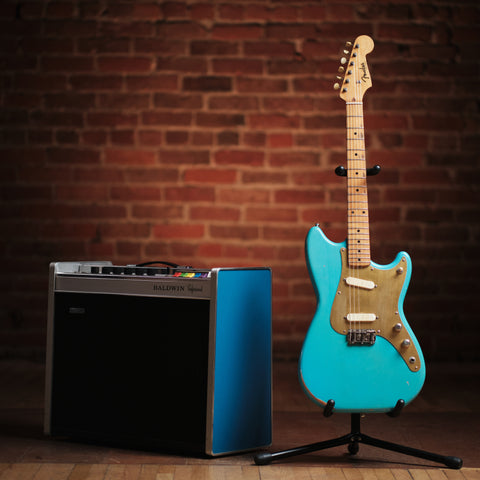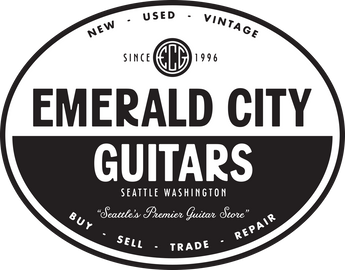1952 Gibson J-185

If you know, you know.(And if you don’t know, we don’t blame you at all.) During its 8 years of production less than 1000 J-185s were produced, only 648 of which were sunburst models. Technically speaking, you’re more than twice as likely to come across a ’58-’60 “Burst” Les Paul than you are one of these.
In addition to its rarity, though, the J-185 is widely considered to be Gibson’s finest post-war flat-top ever produced. Often erroneously considered a “mini J-200”, its shape is actually identical to Gibson’s iconic and much more manageable 16” L-5. A simple belly bridge was used in place of the ostentatious and structurally suspect mustache variety. The 185’s light build and scalloped bracing remained immune from the constant anatomical experimentation that plagued many 200s of the era. A standard 24 3/4” scale even managed to tone down the boominess and accentuate a clearer midrange. So why did the 185 fail to reach the same production numbers as many of its cousins? My best guess is because it aimed for a strange niche in the marketplace. The everyman in need of a workhorse was covered by the J-45 or J-50. The big spender looking for flash went with the top-of-the-line J-200. I’d consider the thousand or so who fell in the middle to be some of the luckiest Gibson customers of their generation.
1957 Fender Duo Sonic

The most keen-eyed ECG fans out there might remember a 1954 Strat we recently sold, a one-off custom color in a unique light blue with gold anodized pickguard. It was truly one of the most special Fender guitars I’ve ever been lucky enough to handle.
So a few months ago when we came across the stripped carcass of this Duo Sonic, it was clear enough that I wouldn’t be shooting this one in Desert Sand. The neck is dated 1-57, and is remarkably similar in profile and feel to a Strat from the same period. The shape is a perfect transition between the chunky C indicative of ’56 and the iconic sharp V of the following year. While this may not be the most original example out there, I can say with extreme bias that it is absolutely the coolest. If you liked our blue ’54 Strat but couldn’t scrape up six figures, this seems like the perfect consolation prize.
1960 Fender Stratocaster

What can I say about slab board Strats that hasn’t already been said? Arguably Fender’s best guitar design of all time being manufactured in its optimum configuration, just a few years before production was to skyrocket and quality would begin to wane with CBS at the helm.
There are many opinions regarding the exact timeframe of Fender’s “golden age,” but you can bet that 1960 is ubiquitously included. This particular guitar is a one owner instrument, an occurrence becoming more and more scarce by the day. We were able to acquire it from the son of the original owner, who had been in the military and taken the guitar all over the world. Some time during its travels, perhaps in Germany, the original Kluson tuners were replaced with a Schaller set. Apart from this misstep, the guitar has remained completely untouched since its days at the Fender factory. How many one owner slab board Strats are still out there? Only God knows for sure, but I can guarantee it’s not many.
1956 Gibson Les Paul Jr

The cheese pizza carries an unspoken power in our culinary lexicon. On paper, there are many better equipped options. In practice, though, simplicity is the ingredient that elevates any recipe to a level greater than the sum of its parts. This sentiment is well understood by those of us who fawn over the Les Paul Junior.
Hewn from a flat slab of wood and equipped with the most basic hardware, the design sensibilities seem to be straight from the bench of Leo Fender. However the all-Mahogany construction and P90 pickup are just enough to remind you this one is from Kalamazoo after all.
This particular example is clean enough to hang in the living room, but sports just enough natural wear to make playing out a guilt-free experience. With Les Paul Standards from the same year creeping steadily towards six-figure territory, now may be the time to prove that less is more
The Slim Dossey Collection

Guitar dealers referring to their instruments as “pieces of history” has been pretty squarely run into the ground in recent times. If it has ever been deserved, though, it would be in reference to this collection of instruments and memorabilia that came to us from the legendary Slim Dossey.
His biography reads a little like Forrest Gump. Born Warner Garvin Dossey in Central Kentucky, his early days saw him crossing paths with local figures such as Merle Travis and Ike Everly. After hitching a train to Washington as a teen for a job picking apples, he found himself playing guitar for Northwest legend Texas Jim Lewis.
In 1953 Slim moved to Los Angeles and immediately found himself band leader on Town Hall Party and in Smokey Roger’s Western Caravan. Throughout the 1950s he played and sang with everyone you could imagine: Jimmy Bryant, Spade Cooley, Jimmy Wakely, Eddy Arnold, the list goes on. He was even roommates with steel guitar legend Joaquin Murphey for a time.
His next unlikely employment came about when returning some loaned instruments back to Fender after going on tour with the Sons of the Pioneers. During his visit, Forrest White was so charmed by Slim that he offered him a job as an artist liaison. Slim was in charge of giving visiting stars a guided tour of Fender’s operation. (When tours were slow he would cover tweed amps.) During this time, he was gifted these guitars by Fender as a token of appreciation. Like many of Fender’s old guard, the CBS takeover of 1965 didn’t sit well with Slim, who moved to Idaho shorty thereafter where he would live out the rest of his life.
Slim continued to write and play music until his passing in 2012, just a week short of his 94th birthday. He is a Western Swing Hall of Fame member and one of the truly underappreciated heroes of early country music. To be able to represent these instruments along with his matching Nudie suits is sincerely a humbling experience and an absolute honor for our shop.



